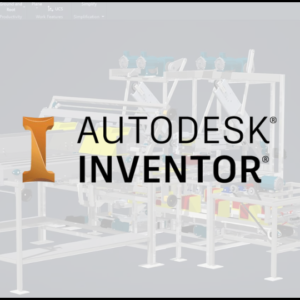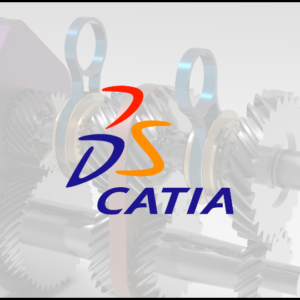Description
NX CAD is a powerful computer-aided design (CAD) software developed by Siemens. It’s widely used in engineering and product design for creating 3D models, simulations, and assemblies. NX CAD integrates various functions like design, engineering analysis, and manufacturing into a single platform.
Key Features:
NX CAD offers a range of features that make it a comprehensive tool for design and engineering:
- 3D Modeling: Advanced tools for creating and editing complex 3D models, including parametric, direct, and synchronous modeling techniques.
- Assembly Design: Capabilities for managing large assemblies, including tools for positioning, interference checking, and assembly visualization.
- Sheet Metal Design: Specialized tools for designing and unfolding sheet metal parts.
- Drafting: Tools for creating detailed 2D drawings from 3D models, including dimensioning, annotations, and tolerancing.
- Simulation and Analysis: Integrated simulation tools for structural, thermal, and fluid flow analysis, enabling virtual testing of designs.
- Manufacturing: Features for preparing designs for manufacturing, including toolpath generation for CNC machining and additive manufacturing (3D printing).
- Product Lifecycle Management (PLM) Integration: Seamless integration with PLM systems for managing design data, version control, and collaboration.
- Design for Assembly (DFA): Tools to optimize designs for ease of assembly and reduce manufacturing costs.
- Customization and Automation: Scripting and customization options to automate repetitive tasks and tailor the software to specific workflows.
- Collaborative Tools: Features for team collaboration, including sharing models and design data with stakeholders and working on designs concurrently.
Benefits:
The benefits of using NX CAD are significant for both individual users and organizations:
- Enhanced Productivity: With integrated tools for design, analysis, and manufacturing, NX CAD reduces the need for data transfers between different software, speeding up the design process.
- Improved Design Quality: Advanced modeling and simulation capabilities help identify and address design issues early in the development process, leading to higher-quality products.
- Reduced Time-to-Market: Streamlined workflows and efficient collaboration tools help accelerate the design and manufacturing process, allowing products to reach the market faster.
- Cost Savings: By optimizing designs for manufacturability and enabling virtual testing, NX CAD can reduce prototyping costs and minimize errors that could lead to costly revisions.
- Scalability: NX CAD supports a wide range of applications, from small components to large assemblies, making it suitable for various industries and project sizes.
- Flexibility and Customization: The ability to customize and automate processes allows users to tailor the software to their specific needs and workflows, enhancing efficiency.
- Integrated PLM: Seamless integration with PLM systems ensures better data management, version control, and collaboration across teams, improving overall project coordination.
- Advanced Analysis: Built-in simulation tools enable thorough testing of designs under various conditions, improving reliability and performance.
- Collaboration: Enhanced collaborative features facilitate teamwork and communication, making it easier to share designs and feedback across different departments and locations.
- Future-Proofing: Regular updates and support for the latest technologies ensure that NX CAD remains relevant and capable of handling evolving industry demands and technological advancements.
Course Structure
A typical NX CAD course structure might include the following modules or topics:
- Introduction to NX CAD:
- Overview of NX CAD and its interface
- Basic navigation and toolbars
- Understanding file management and project organization
- Fundamentals of 3D Modeling:
- Introduction to parametric, direct, and synchronous modeling
- Creating and editing basic 3D shapes
- Applying constraints and dimensions
- Advanced Modeling Techniques:
- Creating complex geometry and features
- Advanced surface modeling
- Managing large assemblies and subassemblies
- Drafting and Documentation:
- Generating 2D drawings from 3D models
- Adding dimensions, annotations, and symbols
- Creating and managing drawing sheets and templates
- Sheet Metal Design:
- Designing sheet metal parts and assemblies
- Using sheet metal tools for unfolding and creating bend tables
- Creating flat patterns for manufacturing
- Simulation and Analysis:
- Introduction to simulation tools and their applications
- Performing structural, thermal, and fluid flow analysis
- Interpreting simulation results and optimizing designs
- Manufacturing Preparation:
- Generating toolpaths for CNC machining
- Preparing designs for additive manufacturing (3D printing)
- Understanding manufacturing constraints and requirements
- Product Lifecycle Management (PLM) Integration:
- Basics of PLM systems and their integration with NX CAD
- Managing design data and versions
- Collaboration and data sharing within PLM environments
- Customization and Automation:
- Using scripting and macros to automate tasks
- Customizing the NX CAD environment to fit specific needs
- Creating custom tools and features
- Project Work and Case Studies:
- Applying learned skills to real-world projects
- Analyzing and solving design problems
- Presenting and reviewing project work
- Review and Assessment:
- Recap of key concepts and techniques
- Practical assessments and exams
- Feedback and improvement areas
Assessment
- Assessments:
- Completing quizzes and assignments to test knowledge.
- Final Project:
- Submitting a final project that demonstrates proficiency.
Course Duration:
- Essential: 50-60 hours
- Proficient: 110-120 hours
- Expert: 170-180 hours
- Project: 15-20 hours
Assessment:
- Quizzes at the end of each module
- Practical assignments and exercises
- Final capstone project
Deliverable:
- Lifetime Access to Digital Notes.
- Lifetime Doubts Clearning.
- Authorized Certificate From MSME, ISO 9001:2015 , Govt. of India, etc.
Skills Acquired:
By completing an NX CAD course, you can acquire a range of valuable skills:
- 3D Modeling Proficiency: Ability to create and manipulate complex 3D models using various modeling techniques (parametric, direct, synchronous).
- Advanced Design Capabilities: Expertise in creating intricate designs and assemblies, managing large assemblies, and integrating different design features.
- Drafting and Documentation Skills: Competence in generating detailed 2D drawings, including dimensions, annotations, and symbols, and creating documentation for manufacturing.
- Sheet Metal Design: Knowledge of designing sheet metal parts, creating flat patterns, and understanding sheet metal manufacturing processes.
- Simulation and Analysis: Skills in performing and interpreting simulations for structural, thermal, and fluid flow analysis, and optimizing designs based on simulation results.
- Manufacturing Preparation: Ability to prepare designs for various manufacturing processes, including CNC machining and additive manufacturing, and understanding related constraints.
- PLM Integration: Understanding of how to integrate NX CAD with PLM systems, manage design data, and collaborate effectively within a PLM environment.
- Customization and Automation: Proficiency in using scripting and macros to automate repetitive tasks, customize the NX CAD environment, and enhance workflow efficiency.
- Project Management: Experience in applying NX CAD skills to real-world projects, solving design problems, and presenting work effectively.
- Collaboration and Communication: Enhanced ability to work collaboratively within teams, share designs and feedback, and manage design changes efficiently.
Career Opportunities:
Completing an NX CAD course can open up a variety of career opportunities in design, engineering, and manufacturing across different industries. Here are some potential career paths for those skilled in NX CAD:
- Mechanical Design Engineer:
- Develops and designs mechanical components and systems using NX CAD.
- Creates detailed 3D models and 2D drawings for manufacturing.
- Collaborates with cross-functional teams to optimize designs for performance and manufacturability.
- Product Designer:
- Focuses on the aesthetic and functional aspects of product design.
- Utilizes NX CAD to create innovative product concepts and detailed designs.
- Works closely with marketing and engineering teams to ensure designs meet market needs and technical requirements.
- CAD Technician/Drafter:
- Prepares detailed technical drawings and plans using NX CAD.
- Converts conceptual designs into precise engineering drawings and specifications.
- Works under the supervision of engineers and designers to ensure accurate and consistent documentation.
- CAE (Computer-Aided Engineering) Analyst:
- Performs simulations and analyses using NX CAD’s integrated tools.
- Analyzes structural, thermal, and fluid dynamics aspects of designs to ensure they meet performance criteria.
- Works with design teams to iterate and optimize products based on analysis results.
- Manufacturing Engineer:
- Develops manufacturing processes and tooling using NX CAD.
- Creates CNC programs and toolpaths for precision machining and other manufacturing methods.
- Collaborates with design and production teams to ensure manufacturability and quality.
- Aerospace Engineer:
- Designs and develops components and systems for aircraft and spacecraft.
- Uses NX CAD to create detailed models and simulations for aerodynamics, structures, and materials.
- Works with multidisciplinary teams to meet stringent aerospace standards and regulations.
- Automotive Design Engineer:
- Designs automotive components, such as engines, body panels, and interiors.
- Utilizes NX CAD for modeling, assembly, and analysis of automotive parts.
- Collaborates with other engineers to improve vehicle performance, safety, and aesthetics.
- Industrial Designer:
- Focuses on the usability and appearance of consumer products.
- Uses NX CAD to create prototypes and refine product designs.
- Balances aesthetics, functionality, and manufacturability in product development.
- Tooling Designer:
- Designs molds, dies, jigs, and fixtures using NX CAD.
- Creates detailed tool designs for manufacturing processes, including injection molding, stamping, and casting.
- Works closely with production teams to ensure tools meet quality and efficiency standards.
- PLM Consultant:
- Implements Product Lifecycle Management (PLM) solutions integrated with NX CAD.
- Helps organizations manage design data, workflows, and collaboration effectively.
- Trains users on PLM systems and optimizes processes to enhance productivity.
- CAD Administrator:
- Manages and maintains CAD software and systems within an organization.
- Ensures software updates, licenses, and configurations are up-to-date.
- Provides technical support and training to CAD users.




